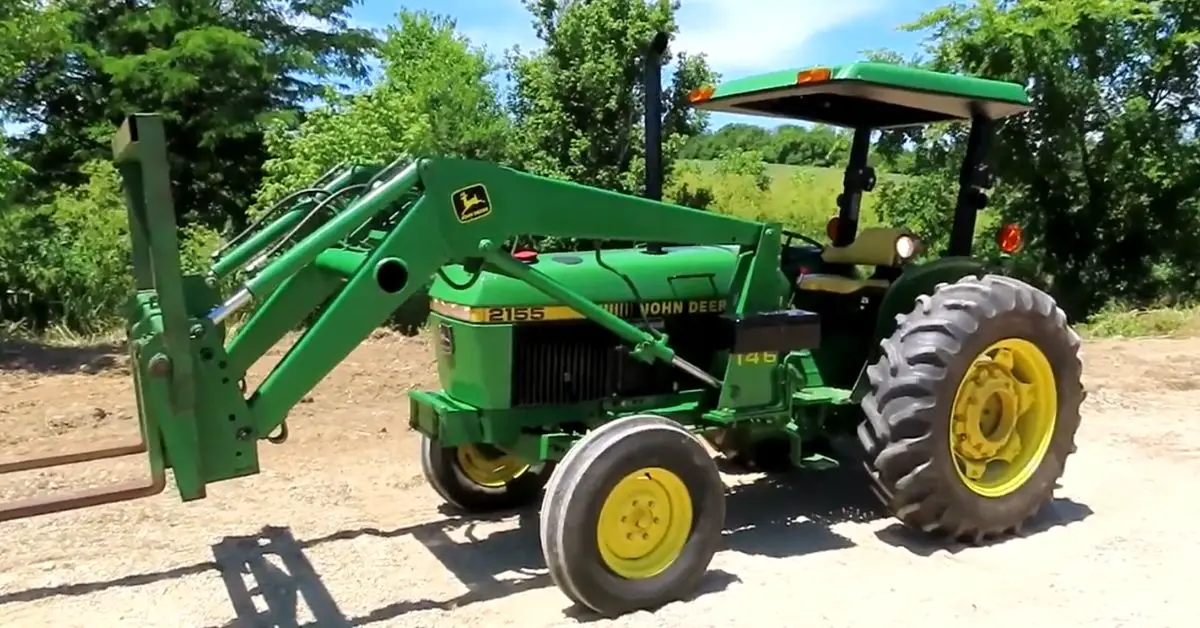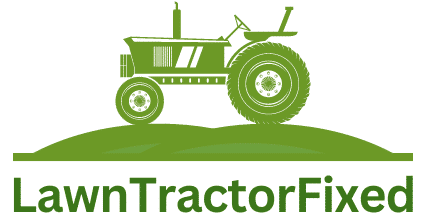The John Deere 2155 is a versatile and durable utility tractor for farmers and agricultural enthusiasts. It has gained popularity for its reliability and performance. However, like any machinery, it is not immune to occasional issues and challenges.
Some of the widely held John Deere 2155 problems are- starting issues, engine troubles, hydraulic system malfunctions, transmission troubles, etc. However, proper care can reduce the rate of such difficulties. And once the issues are seen, you can fix them with some simple repairs.
In this blog, I will delve into several of the common issues that the 55 Utility Series JD 2155 owners might encounter with solutions to keep this machine running smoothly.
What are John Deere 2155 Problems and How to Fix These?
John Deere 2155 is a top-performing farming tractor. However, you may experience a few problems with this machine sometimes.

Several common issues and solutions of the 2155 John Deere tractor are shown in the table below.
| S/N | John Deere 2155 Problems | Solutions |
| 1 | Starting Issues | Clean the battery terminals, check the ignition switch for wear, and replace the fuel filter |
| 2 | Engine Troubles | Clean and inspect the battery terminals for corrosion, test the battery’s voltage to ensure it’s holding a charge, check the wiring and switches for any damage, replace faulty components, and maintain a clean electrical system |
| 3 | Engine Overheating | Clean and inspect the battery terminals for corrosion, test the battery’s voltage to ensure it’s holding a charge, check the wiring and switches for any damage, replace faulty components, and maintain a clean electrical system |
| 4 | Transmission Troubles | Check and replace contaminated fuel, replace the dirty air filter, and examine the spark plugs, fuel injectors, and fuel filters for any clogs or defects. |
| 5 | Electrical System Glitches | Inspect the thermostat for proper operation and replace it if needed; clean the radiator |
| 6 | Hydraulic System Malfunctions | Check the hydraulic fluid level, full the hydraulic tank, bleed the hydraulic system to remove any air, examine the hydraulic hoses for leaks, and replace any damaged ones |
| 7 | Steering and Suspension Issues | Replace worn-out parts |
| 8 | Cooling System Challenges | Clean and inspect the battery terminals for corrosion, test the battery’s voltage to ensure it’s holding a charge, check the wiring and switches for any damage, replace faulty components, and maintain a clean electrical system |
Now, let’s discuss the issues and the solutions of John Deere 2155 more elaborately.
1. Starting Issues
One of the frequent concerns faced by John Deere 2155 owners is difficulty starting the tractor. This issue can be attributed to several factors, such as a weak battery, faulty ignition switch, or clogged fuel filter.
Regular maintenance checks, including battery testing and fuel system inspection, can help diagnose and prevent these starting woes. Here are some more tips to fix it.
Step 1: Ensure the battery is in good condition,
Step 2: Clean the battery terminals,
Step 3: Check the ignition switch for wear, and
Step 4: Replace the fuel filter if needed. This may cost you around $42.
2. Engine Troubles
Engine issues can stem from various factors, such as fuel quality, air filter clogs, or malfunctioning components. To troubleshoot it, follow the steps below.
Step 1: Check the fuel quality and replace any contaminated fuel.
Step 2: If the engine runs rough or lacks power, inspect the air filter and replace it if it’s dirty. You can get the replacement easily on Amazon for around $50.
Step 3: Also, examine the spark plugs, fuel injectors, and fuel filters for any clogs or defects.
Step 4: Regular maintenance can prevent these issues from arising.
3. Engine Overheating
Overheating is another problem that can plague any tractor, including the John Deere 2155. Excessive heat can lead to engine damage and reduced performance. The cooling system might encounter issues due to low coolant levels, a malfunctioning thermostat, or a worn-out water pump.
The possible solutions are given below.
Step 1: Monitor coolant levels regularly,
Step 2: Inspect the thermostat for proper functioning, and
Step 3: Replace the water pump if needed. It may cost up to $150. So, you might need to inspect the pump twice to be sure about the replacement.
Step 4: Regular cleaning of the radiator and cooling fins can also help maintain proper heat dissipation.
4. Transmission Troubles
Transmission problems can manifest as difficulty shifting gears, grinding noises, or slipping. These issues may arise from low transmission fluid levels, worn-out clutch components, or damaged gears. The below steps could help you fix the trouble.
Step 1: Check the transmission fluid level and ensure it’s within the recommended range.
Step 2: If shifting is difficult, the clutch might need adjustment or replacement. Clutches replacement may need only $25. So if adjustments don’t work, go for replacement.
Step 3: Grinding noises could indicate gear synchronizer issues. It’s advisable to consult a professional technician for more complex transmission problems.
5. Electrical System Glitches
Electrical problems can manifest in various ways, such as flickering lights, malfunctioning gauges, or a dead battery. These issues can stem from corroded connections, damaged wiring, or faulty alternators. The following things will help you troubleshoot the difficulty.
Step 1: Start by cleaning and inspecting the battery terminals for corrosion.
Step 2: Test the battery’s voltage to ensure it’s holding a charge.
Step 3: If lights are flickering or other electrical components aren’t functioning, check the wiring and switches for any damage.
Step 4: Replacing faulty components and maintaining a clean electrical system can mitigate these issues.
6. Hydraulic System Malfunctions
The hydraulic system in the John Deere 2155 is vital for various functions, such as lifting and controlling implements. Leaks, inadequate hydraulic fluid levels, or malfunctioning valves can hamper its performance. So, how do you solve such an issue?
Step 1: Hydraulic issues might result from low hydraulic fluid levels, air bubbles in the system, or damaged hydraulic hoses. Check the hydraulic fluid level and top it up as needed.
Step 2: Bleed the hydraulic system to remove any air, which could cause sluggish performance.
Step 3: Examine the hydraulic hoses for leaks and replace any damaged ones.
Step 4: Regularly inspecting and maintaining the hydraulic system can prevent these problems.
7. Steering and Suspension Issues
Difficult steering, uneven tire wear, or excessive bouncing can indicate problems with the steering and suspension systems. These issues can be caused by worn-out components or improper alignment. You can follow the steps below to fix it.`
Step 1: Regularly check tire pressure, alignment, and suspension components.
Step 2: Address misalignment and replace worn-out parts as needed to ensure smooth steering and proper suspension.
8. Cooling System Challenges
Cooling system problems may arise from low coolant levels, a malfunctioning thermostat, or a clogged radiator. If you notice this on your JD 2155 tractor, do the following things to repair it.
Step 1: Regularly check the coolant level and top it up if necessary.
Step 2: Inspect the thermostat for proper operation and replace it if needed.
Step 3: Clean the radiator to ensure efficient heat dissipation.
Step 4: Preventive maintenance, such as flushing the cooling system, can help avoid these problems.
FAQs
Q. What are common uses for the John Deere 2155 tractor?
A. The John Deere 2155 is often used for a wide range of tasks on farms and other agricultural operations, including plowing, tilling, mowing, hauling, and operating various implements.
Q. What are the key features of the John Deere 2155?
A. Here are the key specifications of the John Deere 2155 farming tractor-
- Engine Type: 3-cylinder diesel engine
- Displacement: 179 ci or 2.9 L
- Engine Horsepower: 55 hp or 41.0 kW
- Transmission Type: Non-synchronized
- Rated RPM: 2300 (CST) or 2500 (TSS)
- Fuel Tank Capacity: 17.7 gal or 67.0 L
- Gears: 8 forward and four reverse
Q. Is John Deere 2155 suitable for small farms or large agricultural operations?
A. The John Deere 2155 is a compact utility tractor, making it well-suited for smaller farms, landscaping, and light to medium-duty tasks. However, it can also be used in larger agricultural operations for specific tasks.
Q. What maintenance is required for the John Deere 2155?
A. Regular maintenance for the John Deere 2155 includes oil and filter changes, checking fluid levels, inspecting and lubricating components, and keeping the tractor clean. Refer to the operator’s manual for a detailed maintenance schedule.
Q. Where can I find replacement parts for the John Deere 2155?
A. John Deere dealerships and authorized parts distributors are the best places to source genuine replacement parts for the John Deere 2155. Online retailers may also offer aftermarket and compatible parts.
Conclusion
Since John Deere 2155 is a trustworthy tractor, problems may arise over time. Regular maintenance and inspections can significantly extend the lifespan of your tractor and keep it performing optimally.
JD 2155 owners can resolve these common problems by staying vigilant and following recommended maintenance schedules. Embark on the benefits of this reliable agricultural workhorse for years to come.
Hi! I’m Wesley Thomas, a mechanical engineer with over 5 years experience in the garden and heavy machinery. I'll guide you to fix lawn tractors and mowers issues as well as other machineries used in lawn projects. Read my blogs and make your mowing and lawn projects easier.

